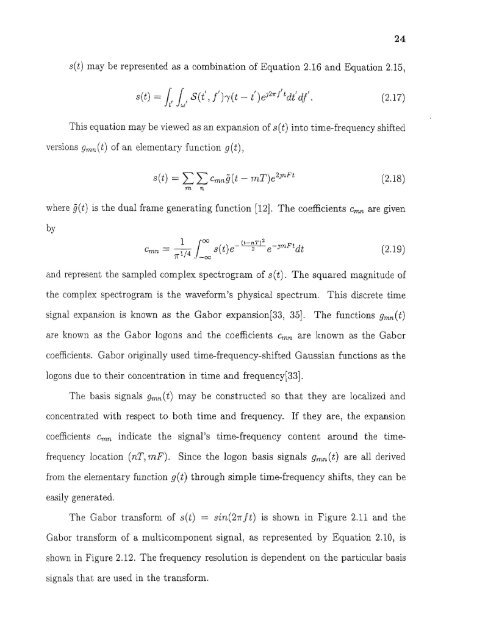Space/time/frequency methods in adaptive radar - New Jersey ...
Space/time/frequency methods in adaptive radar - New Jersey ...
Space/time/frequency methods in adaptive radar - New Jersey ...
Create successful ePaper yourself
Turn your PDF publications into a flip-book with our unique Google optimized e-Paper software.
24s(t) may be represented as a comb<strong>in</strong>ation of Equation 2.16 and Equation 2.15,This equation may be viewed as an expansion of s(t) <strong>in</strong>to <strong>time</strong>-<strong>frequency</strong> shiftedversions gm?, (t) of an elementary function g (t) ,where g(t) is the dual frame generat<strong>in</strong>g function [12]. The coefficients c„ are givenbyand represent the sampled complex spectrogram of s(t). The squared magnitude ofthe complex spectrogram is the waveform's physical spectrum. This discrete <strong>time</strong>signal expansion is known as the Gabor expansion[33, 351. The functions g(t)are known as the Gabor logons and the coefficients c„ are known as the Gaborcoefficients. Gabor orig<strong>in</strong>ally used <strong>time</strong>-<strong>frequency</strong>-shifted Gaussian functions as thelogons due to their concentration <strong>in</strong> <strong>time</strong> and <strong>frequency</strong>[33].The basis signals gmn(t) may be constructed so that they are localized andconcentrated with respect to both <strong>time</strong> and <strong>frequency</strong>. If they are, the expansioncoefficients c„, <strong>in</strong>dicate the signal's <strong>time</strong>-<strong>frequency</strong> content around the <strong>time</strong><strong>frequency</strong>location (nT , m F) . S<strong>in</strong>ce the logon basis signals g(t) are all derivedfrom the elementary function g (t) through simple <strong>time</strong>-<strong>frequency</strong> shifts, they can beeasily generated.is shown <strong>in</strong> Figure 2.11 and theGabor transform of a multicomponent signal, as represented by Equation 2.10, isshown <strong>in</strong> Figure 2.12. The <strong>frequency</strong> resolution is dependent on the particular basissignals that are used <strong>in</strong> the transform.
















